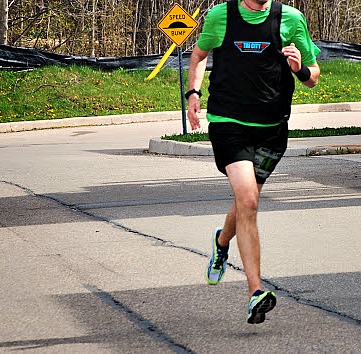Runners are often told to run on grass rather than pavement for obvious reasons. Humans also evolved to run on increasingly dry and open grasslands, not on pavement.
 However, the research behind Lieberman’s work tells us how and why forefoot runners are able to run on pavement, barefoot or shod, without getting injured and heel strikers are not so fortunate.
However, the research behind Lieberman’s work tells us how and why forefoot runners are able to run on pavement, barefoot or shod, without getting injured and heel strikers are not so fortunate.
The evidence comes from an array of data that shows that heel striking leads to injury regardless of surface hardness, or softness. How so? The heel strike-transient.
Its well-known that all landing strategies in running produce a ground reaction force, however heel strike running produces a component of the ground reaction force, called the heel strike-transient, that is not observed in a forefoot strike. Because the heel strike-transient is absent in forefoot running, forefoot runners can run on pavement without more impact compared to heel strikers.

Another downfall of the ground reaction force at heel strike is that it occurs at a magnitude between 1.5 and 2.5 body weights.
- the impact at heel strike transmits as a shock-wave up the body and can be measured in the tibia within a few milliseconds (ms) and in the head 10 ms later
The ground reaction force sounds painful, right?
Unfortunately, heel strikers generally don’t feel the ground reaction force due to the thick-cushioned heeled shoe which only dampens impact by 10%.
The Problem is Heel Striking, Not Surface
The magnitude and the heel strike-transient of the ground reaction force at heel strike is the problem, not the surface you are running on. The force is produced even when running on grass, or soft trails with a heel strike. As long as you heel strike, the heel strike-transient will always be produced.
Researchers believe that since forefoot running reduces over-striding by keeping foot strike position closer to the body via knee flexion, ankle plantarflexion, and forward leaning, the ground reaction force is lowered, the heel strike-transient is eliminated and therefore, a forefoot runner can run on hard surfaces without injury.
Remember, it’s not the surface that causes injury, it’s the foot strike technique in the form of a heel strike.
More on Forefoot Striking:
- Obese People Run with Less Impact with Forefoot Running
- Forefoot Strike Running Prevents Lower Leg Injury
- Forefoot Running Eliminates Shin Splints
- Learn Forefoot Running
Run Right with a Forefoot Strike !
References:
Cavanagh, PR and Lafortune, MA. Ground reaction forces in distance running. J Biomech, 1980; 13(5):397-406.
Lieberman, D. What we can learn from barefoot running: an evolutionary medical perspective. Exerc Sport Sci Rev, 2012; 40(2):63-72
Bretta Riches
BSc Neurobiology; MSc Biomechanics candidate, ultra minimalist runner & founder of RunForefoot. I was a heel striker, always injured. I was inspired by the great Tirunesh Dibaba to try forefoot running. Now, I'm injury free. This is why I launched Run Forefoot, to advocate the health & performance benefits of forefoot running and to raise awareness on the dangers of heel striking, because the world needs to know.
Latest posts by Bretta Riches (see all)
- Forefoot Running and Achilles Pain - 19/04/2024
- Does Foot Strike Really Matter in Running? YES! - 17/04/2024
- Heel Lifts Increase Injury in Runners - 16/04/2024

Leave a Reply